Shipyard Employment eTool
Materials Handling (including Gear and Equipment for Rigging) >> Hoisting and Hauling Equipment
Hoisting and hauling equipment is used to move heavy loads. Hoisting and hauling equipment may consist of mobile or stationary cranes and derricks and marine railway installations.
Note: Winches and moving parts on hoisting and hauling equipment must be guarded. [29 CFR 1915.115(b) and 29 CFR 1915.131(d)]
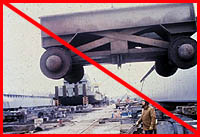
Potential Hazard
Workers can be injured by falling loads, falling booms overturning equipment being caught in moving machinery parts, and being struck by moving machinery or loads.
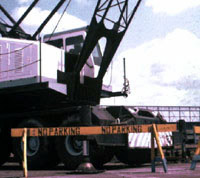
Requirements and Example Solutions
- Derricks and cranes used on vessels must be tested and certified in accordance with the standards provided in 29 CFR 1919. [29 CFR 1915.115(a)(1)]
- Maximum manufacturer's rated safe working loads must be posted and must not be exceeded. [29 CFR 1915.115(c)(1) and (c)(2)]
- The various working radii of the boom and the maximum and minimum radii at which the boom may be safely used with and without outriggers shall be conspicuously posted near the controls and shall be visible to the operator. A radius indicator shall be provided. [29 CFR 1915.115(c)(1)]
- Special precautions should be taken when placing a crane on a vessel (barge) due to [ANSI B30.8-1982 Section 8-1.2.2(3).]:
- Wave movement
- Barge size or stability
- Shifting crane
- Swing radius must be guarded. [29 CFR 1915.115(d)]
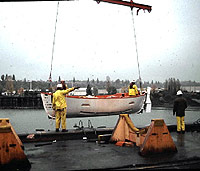
When crawler, locomotive, and truck cranes are used
- Side loading of booms shall be limited to freely suspended loads. Cranes shall not be used for dragging loads sideways. [29 CFR 1910.180(h)(3)(iv)]
- Neither the load nor the boom shall be lowered below the point where less than two full wraps of rope remain on their respective drums. [29 CFR 1910.180(h)(3)(x)]
- When two or more cranes are used to lift one load, one designated person shall be responsible for the operation. This person shall be required to analyze the operation and instruct all personnel involved in the proper positioning, rigging of the load, and the movements to be made. [29 CFR 1910.180(h)(3)(xii)]
- The operator shall not be permitted to leave his or her position at the controls while the load is suspended. [29 CFR 1910.180(h)(4)(i)]

Additional Resources
- ANSI B30.1 through B30.17
- Process: Handling Large Materials. OSHA Shipbuilding and Repair Safety and Health Topics Page.
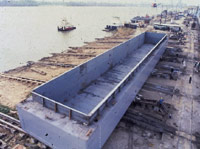
Potential Hazard
Workers can be injured by being struck by moving cradle, machinery parts, and breaking lines.
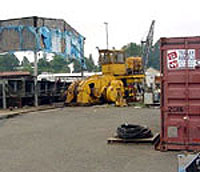
Requirements and Example Solutions
- The cradle or carriage on the marine railway must be positively blocked or secured when in the hauled position to prevent it from being accidentally released. [29 CFR 1915.115(e)(1)]
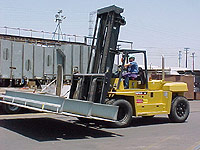
Potential Hazard
Workers can be injured due to lift trucks tipping over, shifting deck plates, dropped loads, or by being struck by moving lift trucks.
Requirements and Example Solutions
Powered industrial trucks are used throughout the shipyard to move material while on the vessel and in the shops. Example elements applicable to Powered Industrial Trucks include:
- Inspection
- Maintenance
- Training [29 CFR 1915.120]
- Overhead protection
- Warning devices
- Operational
Refer to the Powered Industrial Trucks Safety and Health Topics Page for a more in-depth discussion.
Additional Resources
- Powered Industrial Trucks. OSHA Safety and Health Topics Page.
- 29 CFR 1910.178, Powered Industrial Trucks. OSHA Standard.

